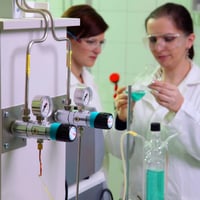Summary GCE introduces GCE Speciality as a dedicated divisional brand focusing on high-purity gas...
Role of Flashback Arrestors in Welding Safety
Every welder knows safety comes first. Whether it's a major project or a small repair, maintaining a hazard-free workspace is essential. One of the key risks welders face is flashbacks. Fortunately, they can be prevented by a simple but effective safety device—flashback arrestors.
Read on to explore flashbacks in detail, their causes, and how flashback arrestors play a vital role in welding safety.
What Is Flashback in Welding?
Flashback in welding occurs when the flame from the torch moves backward into the gas source. While it's a rare event, it's crucial to be aware of, as it can lead to hazards. Thankfully, with the right safety measures in place (ex: flashback arrestors), this risk can be easily prevented to ensure a safe and smooth welding process.
Causes of Flashback in Welding
There are several factors that can lead to flashbacks in welding, such as:
- Incorrect Gas Pressure: An imbalance in the pressure of oxygen and fuel gas can cause a flashback. Regularly monitoring the pressure levels and quickly replacing empty tanks can ensure a stable flame.
- Faulty Equipment: Worn-out or damaged hoses, regulators, and torches can trigger flashbacks. Routinely checking the equipment's condition and replacing faulty gear can help prevent these mishaps.
- Improper Lighting Procedures: Incorrectly lighting the torch can sometimes cause the flame to burn back. Follow the proper lighting procedures to avoid this hazard.
- Obstructions in the Hose: Blockages or kinks in the hose can cause back pressure, leading to flashback. Before beginning the welding process, ensure that the hose lines are clear without obstructions.
What Is a Flashback Arrestor?
A flashback arrestor is a safety device designed to prevent flashback by stopping the reverse flow of gases. It serves as a critical line of defence in welding operations. Flashback arrestors come in two main types:
Dry Flashback Arrestors: They use a combination of mechanical components like valves to cut off the gas flow, thus preventing flashbacks. The dry type is the industry standard and the most widely used variety. GCE Industrial exclusively manufactures dry flashback arrestors.
Wet Flashback Arrestors: They use chemicals to extinguish the flame and prevent backflow. The wet type requires a higher maintenance effort compared to their dry counterparts and comes with the risk of contamination.
This blog primarily focuses on dry flashback arrestors.
How Does a Flashback Arrestor Work?
Flashback arrestors work by detecting and stopping the reverse flow of gases. When a flashback occurs, the arrestor activates its safety elements to halt the reverse gas flow and extinguish the flame, protecting both the equipment and the operator.
Safety Elements in a Flashback Arrestor
Flashback arrestors are equipped with various safety features to enhance their protective capabilities. The number of features can range from two to five or more, providing different levels of safety. Generally, more safety features translate to higher security. Here are some of the common safety features you might find in flashback arrestors:
1. Non-Return Valve (NV)
The non-return valve, also known as a check valve, is designed to allow gas to flow in one direction, from the gas supply to the torch. The gas pressure opens the valve, enabling it to pass through. As long as the inlet pressure (supply side) is higher than the outlet pressure (torch side), the valve stays open and allows continuous flow. If backflow occurs, the outlet pressure rises higher than the inlet pressure. In response, the non-return valve quickly shuts, creating a seal that prevents any gas from flowing in the reverse direction.
2. Flame Arrestor (FA)
The flame arrestors typically consist of a porous material with high thermal conductivity. When the flame travels back through the arrestor, it effectively dissipates the heat and cools the flame below its ignition temperature. The flame arrestor also acts as a shield between the flame and the gas supply unit.
3. Thermal Cut-Off Valve (TV)
This valve is designed with a thermal threshold and activates when it detects excessive heat caused by flashbacks. It uses either a fusible element that melts at a specific temperature or a heat sensor that detects temperature changes. When the temperature crosses the threshold, this valve cuts off the gas supply to prevent further combustion.
4. Pressure-Sensitive Cut-Off Valve (PV)
This valve works just like the thermal cut-off valve but detects anomalies in the gas pressure and stops the flow to prevent accidents.
5. Filter (FL)
The filter removes impurities from the gas, ensuring that clean gases are used and reducing the risk of flashback caused by contaminants.
Are Flashback Arrestors Necessary?
Absolutely! In many countries and regions, the use of flashback arrestors is mandatory due to their critical role in preventing accidents and ensuring the safety of welding operations. The benefits of using flashback arrestors far outweigh the costs, as they improve both safety and productivity.
Why Use GCE Industrial Flashback Arrestors?
When it comes to choosing flashback arrestors, GCE Industrial stands out as a reliable choice. Here's why:
Industry Leaders: GCE has been involved in the gas control business for over a century, contributing to the efficiency of cutting and welding processes. Our commitment to creating a safer work environment for our customers drives us to create secure and efficient equipment.
Expert Knowledge: Our in-depth knowledge of gas control and understanding of the challenges of welding translate into reliable flashback arrestors.
Safety Standards: GCE Industrial's flashback arrestors comply with ISO 5175-1 and other international safety standards, ensuring top-notch safety and performance.
Investing in high-quality flashback arrestors, like those from GCE Industrial, not only complies with safety regulations but also enhances overall safety and productivity in welding operations.



